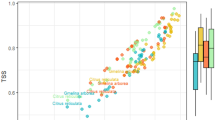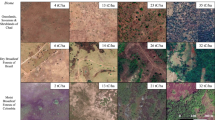Abstract
Meeting demands for agricultural production while maintaining ecosystem services, mitigating and adapting to climate change and conserving biodiversity will be a defining challenge of this century. Crop production in agroforests is being widely implemented with the expectation that it can simultaneously meet each of these goals. But trade-offs are inherent to agroforestry and so unless implemented with levels of canopy cover that optimize these trade-offs, this effort in climate-smart, sustainable intensification may simply compromise both production and ecosystem services. By combining simultaneous measurements of production, soil fertility, disease, climate variables, carbon storage and species diversity along a shade-tree cover gradient, here we show that low-to-intermediate shade cocoa agroforests in West Africa do not compromise production, while creating benefits for climate adaptation, climate mitigation and biodiversity. As shade-tree cover increases above approximately 30%, agroforests become increasingly less likely to generate win–win scenarios. Our results demonstrate that agroforests cannot simultaneously maximize production, climate and sustainability goals but might optimise the trade-off between these goals at low-to-intermediate levels of cover.
This is a preview of subscription content, access via your institution
Access options
Access Nature and 54 other Nature Portfolio journals
Get Nature+, our best-value online-access subscription
$29.99 / 30 days
cancel any time
Subscribe to this journal
Receive 12 digital issues and online access to articles
$119.00 per year
only $9.92 per issue
Buy this article
- Purchase on Springer Link
- Instant access to full article PDF
Prices may be subject to local taxes which are calculated during checkout


Similar content being viewed by others
Change history
27 July 2020
A Correction to this paper has been published: https://doi.org/10.1038/s41893-020-0594-6
References
Palm, C. A. et al. Identifying potential synergies and trade-offs for meeting food security and climate change objectives in sub-Saharan Africa. Proc. Natl Acad. Sci. USA 107, 19661–19666 (2010).
Lipper, L. et al. Climate-smart agriculture for food security. Nat. Clim. Change 4, 1068–1072 (2014).
Godfray, H. C. J. et al. Food security: The challenge of feeding 9 billion people. Science 327, 812–818 (2010).
Parry, M., Evans, A., Rosegrant, M. W. & Wheeler, T. Climate Change and Hunger: Responding to the Challenge (World Food Programme, Rome, 2009).
Morton, J. F. The impact of climate change on smallholder and subsistence agriculture. Proc. Natl Acad. Sci. USA 104, 19680–19685 (2007).
Garnett, T. et al. Sustainable intensification in agriculture: premises and policies. Science 341, 33–34 (2013).
Campbell, B. M., Thornton, P., Zougmoré, R., van Asten, P. & Lipper, L. Sustainable intensification: What is its role in climate smart agriculture? Curr. Opin. Environ. Sustain. 8, 39–43 (2014).
Nair, P. R. An Introduction to Agroforestry (Kluwer Academic Publishers, Dordrecht, 1993).
Harvey, C. A. et al. Climate-smart landscapes: Opportunities and challenges for integrating adaptation and mitigation in tropical agriculture. Conserv. Lett. 7, 77–90 (2014).
Jose, S. Agroforestry for ecosystem services and environmental benefits: an overview. Agrofor. Syst. 76, 1–10 (2009).
Vaast, P., Harmand, J.-M., Rapidel, B., Jagoret, P. & Deheuvels, O. in Climate Change and Agriculture Worldwide (ed. Torquebiau, E.) 209–224 (Springer Netherlands, Dordrecht, 2016).
Lin, B. B. Agroforestry management as an adaptive strategy against potential microclimate extremes in coffee agriculture. Agric. For. Meteorol. 144, 85–94 (2007).
Tscharntke, T. et al. Multifunctional shade-tree management in tropical agroforestry landscapes—a review. J. Appl. Ecol 48, 619–629 (2011).
Andres, C. et al. Agroforestry systems can mitigate the severity of cocoa swollen shoot virus disease. Agric. Ecosyst. Environ. 252, 83–92 (2018).
Schroth, G., Krauss, U., Gasparotto, L., Duarte Aguilar, J. A. & Vohland, K. Pests and diseases in agroforestry systems of the humid tropics. Agrofor. Syst. 50, 199–241 (2000).
Schroth, G. et al. Contribution of agroforests to landscape carbon storage. Mitig. Adapt. Strat. Glob. Change 20, 1175–1190 (2015).
Schroth, G. et al. Climate friendliness of cocoa agroforests is compatible with productivity increase. Mitig. Adapt. Strat. Glob. Change 21, 67–80 (2016).
Feliciano, D., Ledo, A., Hillier, J. & Nayak, D. R. Which agroforestry options give the greatest soil and above ground carbon benefits in different world regions? Agric. Ecosyst. Environ. 254, 117–129 (2018).
Clough, Y. et al. Combining high biodiversity with high yields in tropical agroforests. Proc. Natl Acad. Sci. USA 108, 8311–8316 (2011).
De Beenhouwer, M., Aerts, R. & Honnay, O. A global meta-analysis of the biodiversity and ecosystem service benefits of coffee and cacao agroforestry. Agric. Ecosyst. Environ 175, 1–7 (2013).
Sanchez, P. A. Science in agroforestry. Agrofor. Syst. 30, 5–55 (1995).
Guo, L. B. & Gifford, R. M. Soil carbon stocks and land use change: A meta analysis. Glob. Change Biol. 8, 345–360 (2002).
Gibson, L. et al. Primary forests are irreplaceable for sustaining tropical biodiversity. Nature 478, 378–381 (2011).
Läderach, P., Martinez-Valle, A., Schroth, G. & Castro, N. Predicting the future climatic suitability for cocoa farming of the world’s leading producer countries, Ghana and Côte d’Ivoire. Climatic Change 119, 841–854 (2013).
Schroth, G., Laderach, P., Martinez-Valle, A. I., Bunn, C. & Jassogne, L. Vulnerability to climate change of cocoa in West Africa: patterns, opportunities and limits to adaptation. Sci. Total Environ. 556, 231–241 (2016).
Franzen, M. & Borgerhoff Mulder, M. Ecological, economic and social perspectives on cocoa production worldwide. Biodivers. Conserv. 16, 3835–3849 (2007).
Phalan, B., Onial, M., Balmford, A. & Green, R. E. Reconciling food production and biodiversity conservation: Land sharing and land sparing compared. Science 333, 1289–1291 (2011).
Blaser, W. J., Oppong, J., Yeboah, E. & Six, J. Shade trees have limited benefits for soil fertility in cocoa agroforests. Agric. Ecosyst. Environ. 243, 83–91 (2017).
Bisseleua, D. H. B., Missoup, A. D. & Vidal, S. Biodiversity conservation, ecosystem functioning, and economic incentives under cocoa agroforestry intensification. Conserv. Biol. 23, 1176–1184 (2009).
Zuidema, P. A., Leffelaar, P. A., Gerritsma, W., Mommer, L. & Anten, N. P. R. A physiological production model for cocoa (Theobroma cacao): model presentation, validation and application. Agric. Syst. 84, 195–225 (2005).
Jacobi, J. et al. Carbon stocks, tree diversity, and the role of organic certification in different cocoa production systems in Alto Beni, Bolivia. Agrofor. Syst. 88, 1117–1132 (2014).
Steffan-Dewenter, I. et al. Tradeoffs between income, biodiversity, and ecosystem functioning during tropical rainforest conversion and agroforestry intensification. Proc. Natl Acad. Sci. USA 104, 4973–4978 (2007).
Wartenberg, A. C. et al. Does shade tree diversity increase soil fertility in cocoa plantations? Agric. Ecosyst. Environ. 248, 190–199 (2017).
Ruf, F. O. The myth of complex cocoa agroforests: The case of Ghana. Hum. Ecol. 39, 373–388 (2011).
Gockowski, J., Afari-Sefa, V., Sarpong, D. B., Osei-Asare, Y. B. & Agyeman, N. F. Improving the productivity and income of Ghanaian cocoa farmers while maintaining environmental services: What role for certification? Int. J. Agric. Sustain. 11, 331–346 (2013).
Abdulai, I. et al. Cocoa agroforestry is less resilient to sub-optimal and extreme climate than cocoa in full sun. Glob. Change Biol. 24, 273–286 (2018).
Carr, M. K. V. & Lockwood, G. The water relations and irrigation requirements of cocoa (Theobroma cacao L.): a review. Exp. Agric 47, 653–676 (2011).
Schroth, G., Läderach, P., Martinez-Valle, A. I. & Bunn, C. From site-level to regional adaptation planning for tropical commodities: cocoa in West Africa. Mitig. Adapt. Strat. Glob. Change 22, 903–927 (2017).
Asase, A., Asitoakor, B. K. & Ekpe, P. K. Linkages between tree diversity and carbon stocks in unlogged and logged West African tropical forests. Int. J. Biodivers. Sci. Ecosyst. Serv. Manag. 8, 217–230 (2012).
Paustian, K. et al. Climate-smart soils. Nature 532, 49–57 (2016).
Jagoret, P., Michel-Dounias, I., Snoeck, D., Ngnogue, H. T. & Malezieux, E. Afforestation of savannah with cocoa agroforestry systems: A small-farmer innovation in central Cameroon. Agrofor. Syst. 86, 493–504 (2012).
Clough, Y., Putra, D. D., Pitopang, R. & Tscharntke, T. Local and landscape factors determine functional bird diversity in Indonesian cacao agroforestry. Biol. Conserv. 142, 1032–1041 (2009).
Abrahamczyk, S., Kessler, M., Dwi Putra, D., Waltert, M. & Tscharntke, T. The value of differently managed cacao plantations for forest bird conservation in Sulawesi, Indonesia. Bird. Conserv. Int. 18, 349–362 (2008).
Teuscher, M. et al. Trade-offs between bird diversity and abundance, yields and revenue in smallholder oil palm plantations in Sumatra, Indonesia. Biol. Conserv. 186, 306–318 (2015).
Kleijn, D. et al. On the relationship between farmland biodiversity and land-use intensity in Europe. Proc. R. Soc. B Biol. Sci. 276, 903–909 (2009).
Nilsson, F. O. L. Biodiversity on Swedish pastures: Estimating biodiversity production costs. J. Environ. Manag. 90, 131–143 (2009).
Hulme, M. F. et al. Conserving the birds of Uganda’s banana-coffee arc: land sparing and land sharing compared. PloS ONE 8, e54597 (2013).
Bhagwat, S. A., Willis, K. J., Birks, H. J. B. & Whittaker, R. J. Agroforestry: a refuge for tropical biodiversity? Trends Ecol. Evol. 23, 261–267 (2008).
Lucey, J. M. & Hill, J. K. Spillover of insects from rain forest into adjacent oil palm plantations. Biotropica 44, 368–377 (2012).
Asare, R. & Ræbild, A. Tree diversity and canopy cover in cocoa systems in Ghana. New For. 47, 287–302 (2016).
Cai, W. et al. Increasing frequency of extreme El Niño eve’nts due to greenhouse warming. Nat. Clim. Change 4, 111 (2014).
Hutto, R. L., Pletschet, S. M. & Hendricks, P. A fixed-radius point count method for nonbreeding and breeding season use. Auk 103, 593–602 (1986).
Parker, T. A. III On the use of tape recorders in avifaunal surveys. Auk 108, 443–444 (1991).
Leather, S. R. Insect Sampling in Forest Ecosystems (Blackwell, Oxford, 2005).
Ferreira, R. B., Beard, K. H. & Crump, M. L. Breeding guild determines frog distributions in response to edge effects and habitat conversion in the Brazil’s Atlantic Forest. PLoS ONE 11, e0156781 (2016).
Kraft, N. J. B. et al. Disentangling the drivers of β diversity along latitudinal and elevational gradients. Science 333, 1755–1758 (2011).
Quinn, G. P. & Keough, M. J. Experimental Design and Data Analysis for Biologists (Cambridge Univ. Press, Cambridge, 2002).
Acknowledgements
We thank K. Oppong and D. Oppong for assistance with fieldwork, and farmers in the study region for allowing access to their farms. We further acknowledge J. O. Fening for institutional support provided by the Soil Research Institute of Ghana. We thank B. Jahn-Humphrey, G. Asamoah, B. Studer, G. Quansah, T. Afreh and M. Amponsah for laboratory assistance. C. Ofori kindly helped us with the identification of frogs. This study was funded by the Sustainable Agroecosystems Group at ETH Zurich and a grant from the Swiss-African Research Cooperation (SARECO) funded by the University of Basel, Switzerland.
Author information
Authors and Affiliations
Contributions
W.J.B., S.P.H. and J.S. designed the research. W.J.B., J.O., J.L. and E.Y. performed the research. W.J.B., S.P.H. and J.S. analysed and interpreted the data. W.J.B. wrote the first draft and S.P.H. and J.S. contributed to revisions.
Corresponding author
Ethics declarations
Competing interests
The authors declare no competing interests.
Additional information
Publisher’s note: Springer Nature remains neutral with regard to jurisdictional claims in published maps and institutional affiliations.
Supplementary information
Supplementary Information
Supplementary Figs 1–3, Supplementary Tables 1–6, Supplementary Methods, Supplementary References
Rights and permissions
About this article
Cite this article
Blaser, W.J., Oppong, J., Hart, S.P. et al. Climate-smart sustainable agriculture in low-to-intermediate shade agroforests. Nat Sustain 1, 234–239 (2018). https://doi.org/10.1038/s41893-018-0062-8
Received:
Accepted:
Published:
Issue Date:
DOI: https://doi.org/10.1038/s41893-018-0062-8
This article is cited by
-
The evolution and future of research on Nature-based Solutions to address societal challenges
Communications Earth & Environment (2024)
-
Disentangling shade effects for cacao pest and disease regulation in the Peruvian Amazonia
Agronomy for Sustainable Development (2024)
-
Shade canopy density variables in cocoa and coffee agroforestry systems
Agroforestry Systems (2024)
-
Response of forage production to drought in silvopastoral systems in Argentina
Agroforestry Systems (2024)
-
Drivers of cocoa agroforestry adoption by smallholder farmers around the Taï National Park in southwestern Côte d’Ivoire
Scientific Reports (2023)



